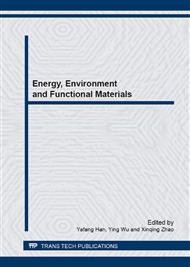p.368
p.373
p.378
p.383
p.387
p.395
p.401
p.407
p.412
Synthesis of Pure Dicalcium Silicate Powder by the Pechini Method and Characterization of Hydrated Cement
Abstract:
Calcium silicate (CS) is a main component of Portland cement and is responsible for the strength development. Recent research has shown that dicalcium silicate cement (CSC) is bioactive and is a potential candidate for bone replacement. Traditionally, dicalcium silicate powder is synthesized by a solid state reaction or a sol-gel method. The solid-state reaction, however, usually needs a higher temperature and a longer calcination time. Furthermore, the dicalcium silicate powder made by the sol-gel method is not pure, and contains a significant quantity of CaO which is harmful to the strength and biological properties of the CSC. The Pechini technique is an alternative, low temperature polymeric precursor route for synthesis of high purity powders. In this study, purer CS powder was synthesized via the Pechini method by calcination at 800°C for 3h. DSC-TGA, XRD, SEM were used for characterization of CS powder and the hydrated cement. The DSC-TGA curves showed that the main exothermic peak was at 479°C and the total mass loss was 79.2%. The XRD patterns of CSC after hydration for 7, 14, and 35 days illustrated that dicalcium silicate hydrate (Ca1.5SiO3.5·xH2O, C-S-H) was formed in the hardened CS paste. The XRD peaks on the diffraction pattern of the C-S-H of the day 35 sample were of greater intensity than those at day 7 and day 14. This demonstrates that the hydration speed was slow and complete hydration could take more than one month. Flake-like crystals were observed on scanning electron micrographs following hardening. The degradation study result showed that there was no mass loss of CSC after the samples were soaked into phosphate buffered saline (PBS) for 40 days. The silicon assay revealed that orthosilicic acid could be released from CSC after the samples were soaked in simulated body fluid (SBF). Silicon is known to be critical to skeletal mineralization. The existence of silicon may stimulate the proliferation of bone and activate cells to produce bone. Investigation of cell attachment confirmed that the MC-3T3 cells attached well to the surfaces of CSC after seeding.
Info:
Periodical:
Pages:
387-394
Citation:
Online since:
April 2014
Authors:
Price:
Сopyright:
© 2014 Trans Tech Publications Ltd. All Rights Reserved
Share:
Citation:


